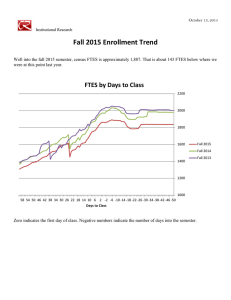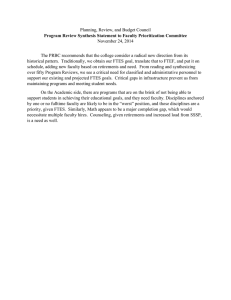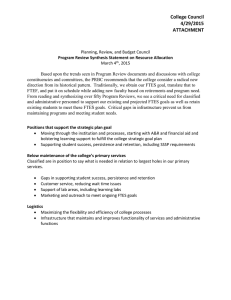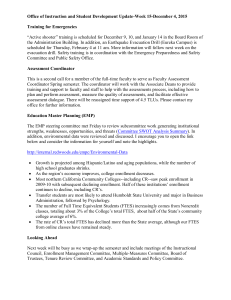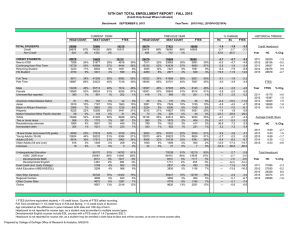Office of Instruction and Student Development Update January 31, 2014
advertisement
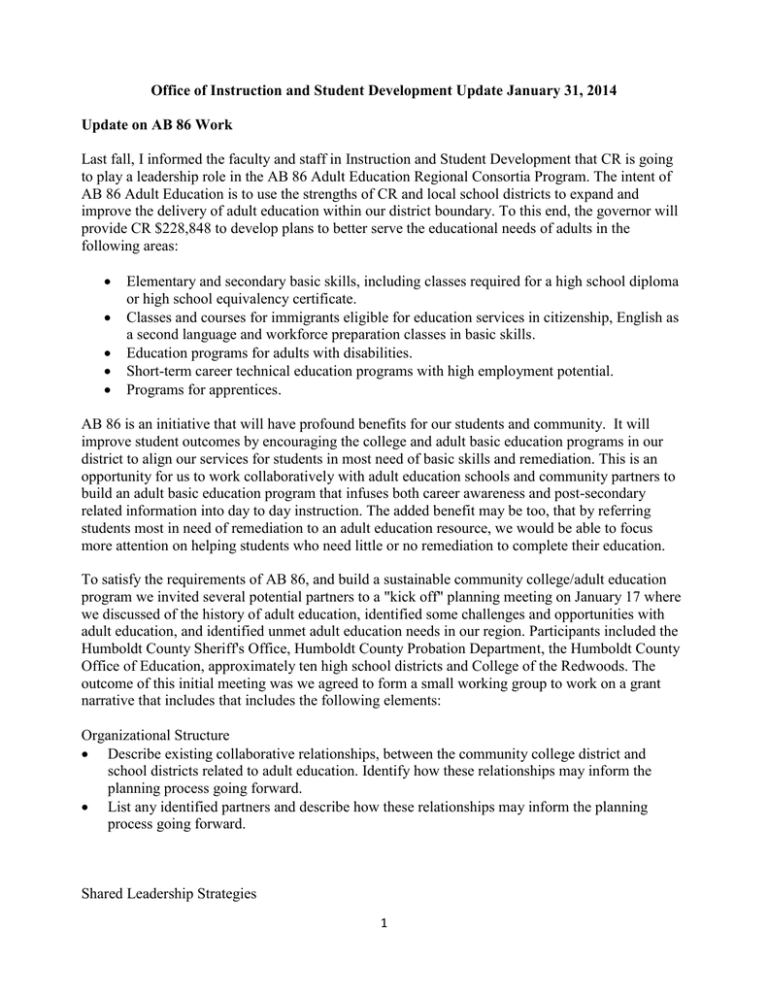
Office of Instruction and Student Development Update January 31, 2014 Update on AB 86 Work Last fall, I informed the faculty and staff in Instruction and Student Development that CR is going to play a leadership role in the AB 86 Adult Education Regional Consortia Program. The intent of AB 86 Adult Education is to use the strengths of CR and local school districts to expand and improve the delivery of adult education within our district boundary. To this end, the governor will provide CR $228,848 to develop plans to better serve the educational needs of adults in the following areas: Elementary and secondary basic skills, including classes required for a high school diploma or high school equivalency certificate. Classes and courses for immigrants eligible for education services in citizenship, English as a second language and workforce preparation classes in basic skills. Education programs for adults with disabilities. Short-term career technical education programs with high employment potential. Programs for apprentices. AB 86 is an initiative that will have profound benefits for our students and community. It will improve student outcomes by encouraging the college and adult basic education programs in our district to align our services for students in most need of basic skills and remediation. This is an opportunity for us to work collaboratively with adult education schools and community partners to build an adult basic education program that infuses both career awareness and post-secondary related information into day to day instruction. The added benefit may be too, that by referring students most in need of remediation to an adult education resource, we would be able to focus more attention on helping students who need little or no remediation to complete their education. To satisfy the requirements of AB 86, and build a sustainable community college/adult education program we invited several potential partners to a "kick off" planning meeting on January 17 where we discussed of the history of adult education, identified some challenges and opportunities with adult education, and identified unmet adult education needs in our region. Participants included the Humboldt County Sheriff's Office, Humboldt County Probation Department, the Humboldt County Office of Education, approximately ten high school districts and College of the Redwoods. The outcome of this initial meeting was we agreed to form a small working group to work on a grant narrative that includes that includes the following elements: Organizational Structure Describe existing collaborative relationships, between the community college district and school districts related to adult education. Identify how these relationships may inform the planning process going forward. List any identified partners and describe how these relationships may inform the planning process going forward. Shared Leadership Strategies 1 Describe the shared leadership strategies that may be used during the planning process. Examples may include meetings, MOUs, co-chairs, decision-making processes (including resource allocation), advisory groups, and consortia member and partner agreements. Project Planning Roles and Responsibilities Identify the co-chairs, project directors, and/or the person(s) responsible for oversight of the project, and describe the roles and responsibilities that they will assume, including the timely submission of required reports. Identify other staffing necessary for planning. Communication Explain how the planning process will be communicated to districts, adult education providers, and other organizations in the region. Describe strategies that might be used for outreach to regional stakeholders. We met the first timetable hurdle by submitting the Certificate of Eligibility to the CCCCO on January 27 (5 days ahead of time). We should receive a notification by February 14 of the intent of the CCCCO to award CR the $228,848 grant funds. The timetable for completion and submission of the remaining planning documents and budget is very short. Everything has to be submitted electronically to California Community College Chancellor’ Office by 5:00pm on February 24. Here’s a quick snapshot of the grant timetable: 02/24/14 Due: Intent-to-Participate Forms, Preliminary Budget Summary, and Project Management Plan 03/5/14 Performance Period Begins 07/31/14 Due: Regional Comprehensive Plan (Completedto-Date) and Expenditure Report 10/31/14 Due: Regional Comprehensive Plan (Completedto-Date) and Expenditure Report 12/31/14 Due: Draft Regional Comprehensive Plan 01/31/15 Due: Expenditure Report 03/01/15 Due: Final Regional Comprehensive Plan 04/30/15 Due: Expenditure Report 06/30/15 Performance Period Ends 08/31/15 Due: Final Expenditure Report Enrollment Update 2 I had the opportunity to present the 2013-16 Enrollment Management Plan to Expanded Cabinet and the Academic Senate last fall. Included in the plan was a “best case” and a more “realistic case” three year FTES projection scenario. Under the best case scenario, the college would attain 4,388 FTES in 2013-14 and maintain 2.5 percent growth in 2014-15 and 2015-16. Resident FTES Best Case 2013-16 FTES Scenario 2012-13 2013-14 2014-15 4,388.00 4,388.00 4,519.64 2015-16 4,655.23 Also included in the plan was a more realistic three year resident FTES scenario. Under this scenario, the 2013-14 FTES target was reduced because fall 2013 was coming in 6.9% below fall 2012. Our 2013-14 FTES report (P-1) showed that we’re close to attaining the reduced realistic target of 4,000 FTES. Resident FTES Realistic Case 2013-16 FTES Scenario 2012-13 2013-14 2014-15 4,388.00 4,000.00 4,137.00 2015-16 4,137.00 It is critically important for use to understand that: Our 2013-14 FTES enrollment projection, and the 2014-15 FTES target, is below the 201314 funded FTES level; We will include enrollments from summer 2014 and summer 2015 in the 2014-15 fiscal year; We will not include summer enrollments in our 2015-16 FTES; We assume that we will continue on enrollment stability at the 2014-15 enrollment level for 2015-16; The loss of FTES, coupled with increasing expenditures, will likely result in a 2014-15 budget shortfall in excess of one million dollars; The budget will be further out of balance for 2014-15 if enrollments continue to fall; and Because we expect to be on stability funding again in 2015-16, the only revenue increases that year will be any State funded COLA and any increases in non-resident tuition and other revenue such as noncredit. Conversations about how we can increase enrollment will be held in several integrated planning and governance bodies. I am confident that a lot of wonderful ideas will come from those conversations—ideas that we can implement immediately. While we have to look at ways to positively influence our 2014-15 enrollments, it is in the best interest of the college that we look at our enrollment problem strategically. I would offer that our strategic conversations should include the following elements: Continue using a data informed process for enrollment and budget planning. It will be impossible for us to plan strategically if we don’t base our planning on reliable, comprehensive data. 3 Clarify what degrees the college should offer that provide effective pathways that help students succeed and that we can fiscally support. We offer several degrees and certificates, and are mandated to offer more with the ADTs. It’s important that we evaluate our degree plans and ensure that our degree plans are actually available to students and the courses in those plans are offered with sufficient capacity to meet student need. Develop institutional plans that include comprehensive retention initiatives. Think of the variety of students we serve: traditional high school graduates, adult learners, students wanting associate degrees, students seeking vocational degrees, continuing education students, online learners, first generation college students, underprepared students, and students who have work and/or family obligations in addition to their classes. It’s imperative that we have assessments and intervention initiatives in our retention plan so we can intervene with students before they decide to leave school. These assessments will help us understand where to focus our limited resources most effectively so we can have the greatest impact on student success. Use cost/benefit and return on investment analysis for recruitment and retention initiatives. We have to do more with fewer resources. Simply put, we have to prioritize strategies that will have the greatest impact on student enrollment and success. 4
